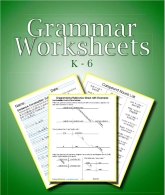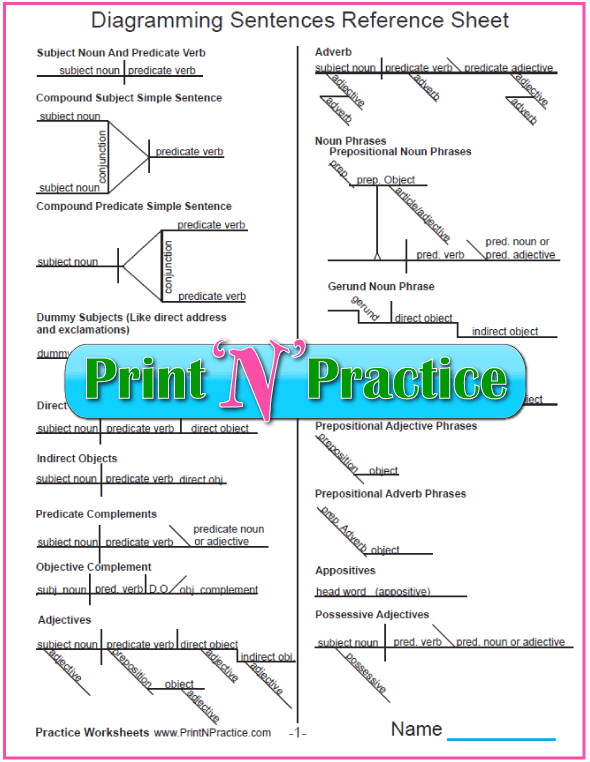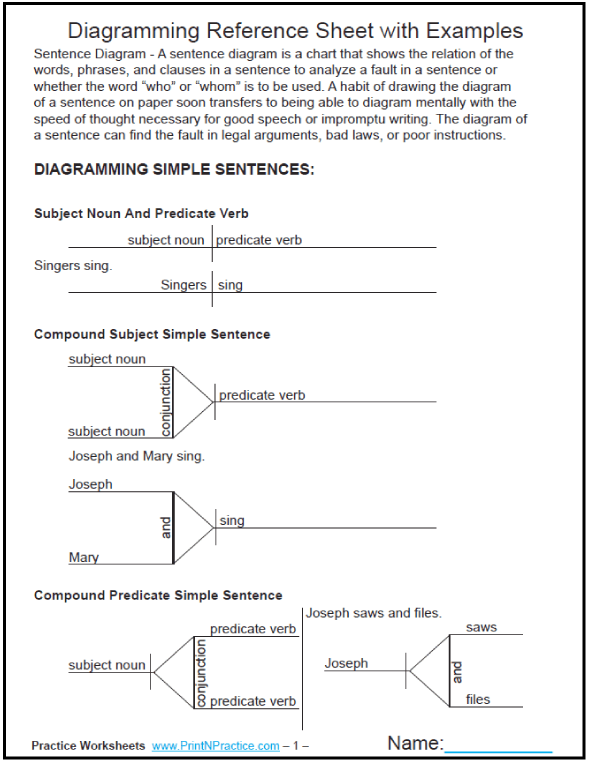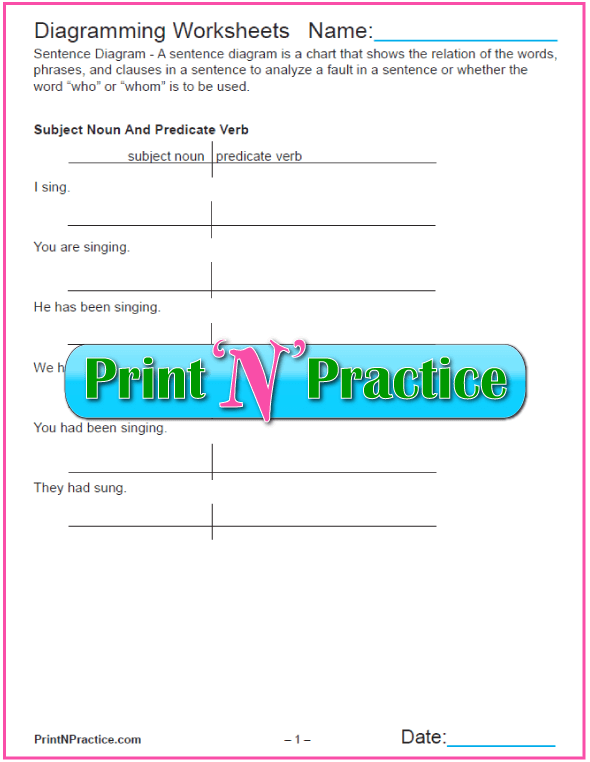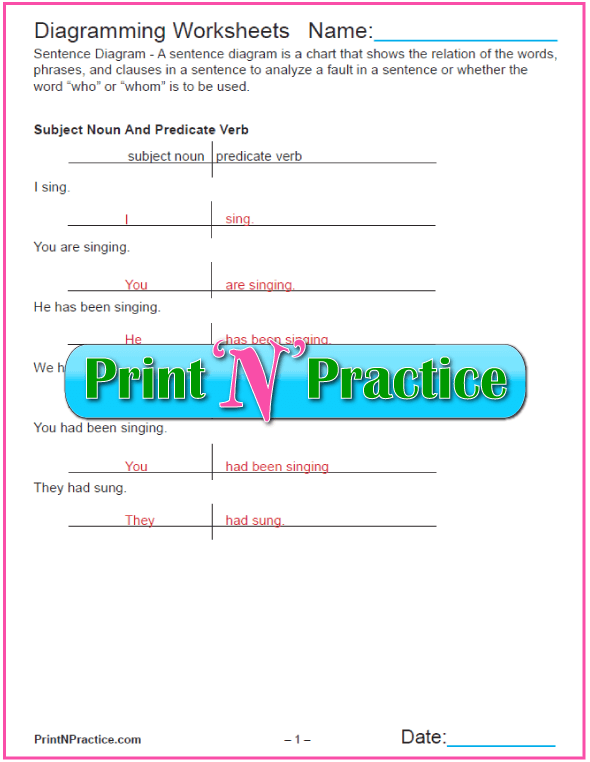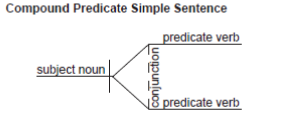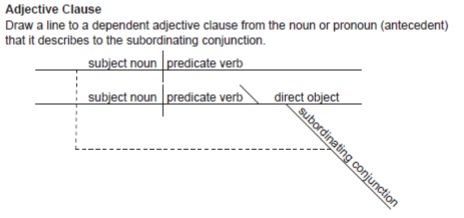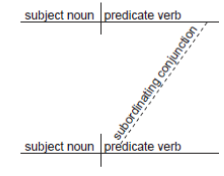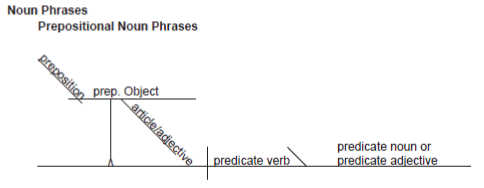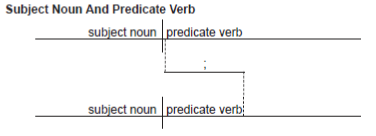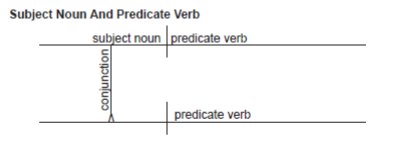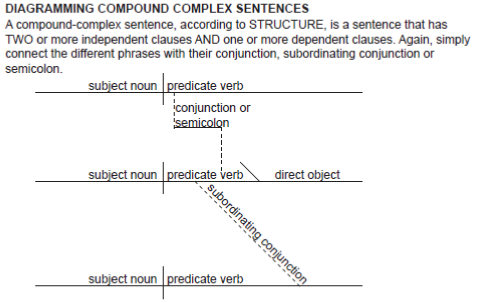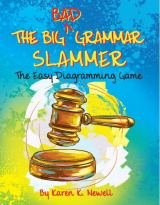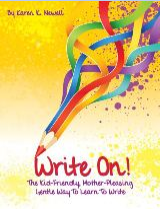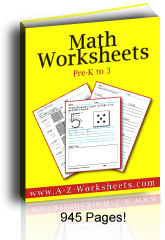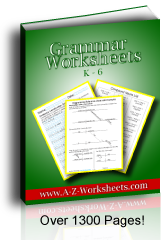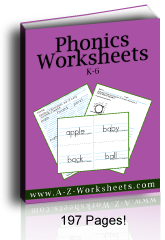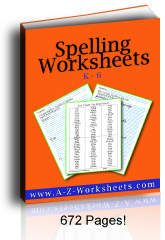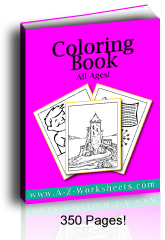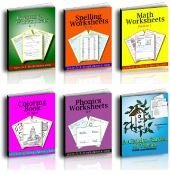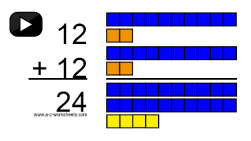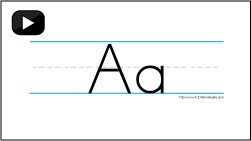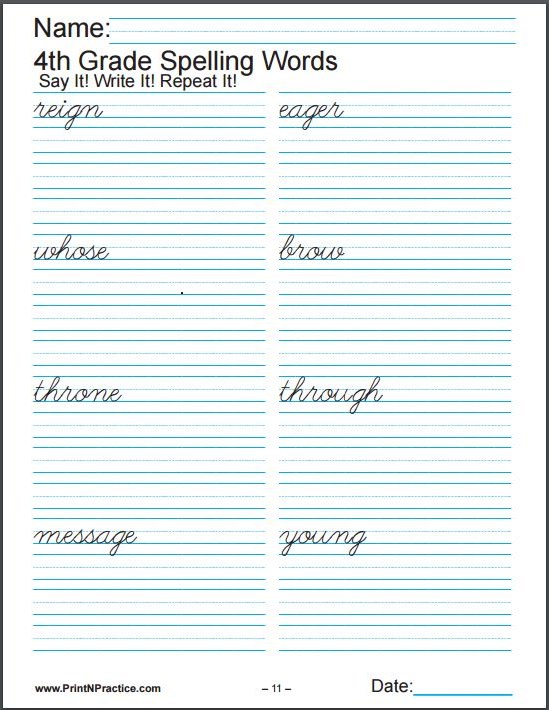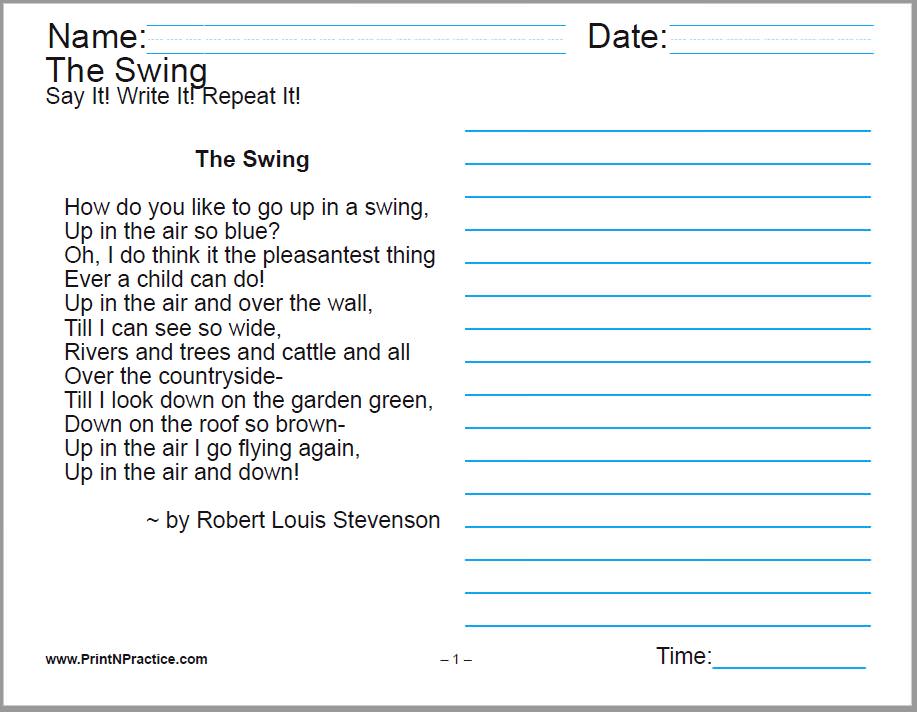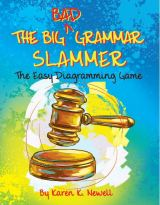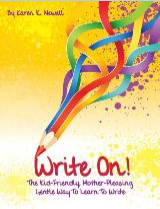Our Diagramming Sentences Worksheets Are Easy: Learn American English Grammar At A Glance
Diagramming Sentences Worksheet Charts
Picture the sentence! Our diagramming sentences worksheet PDFs show the parts of speech on the chart where they go.
Analyzing and beginning to diagram English sentences can be so much fun if the children know what they're supposed to do.
It's like a puzzle. Parsing on a diagram is the easiest way for kids to picture English grammar, and its my favorite way to present diagrams.
When I am teaching about the different grammatical terms, I put a diagram right at the top of the board and work from there.
I constantly name the subject, verb, and object so that extra memorizing is not necessary for the children to understand their placement (although it is very good to memorize the definitions as well).
Analyzing is so much easier when there is a chart, a map for the words. You can use PrintNPractice worksheets as blanks or models for your own sentences.
Be encouraged to stay in touch! Join my free newsletter....
Join To Receive My Free PrintNPractice Newsletters!
Free Online Worksheets For School, Homework, And Homeschool Practice
Free Online Teacher Resources - Free Homeschool Curriculum
For teachers and parents: PrintNPractice free printable worksheets are all copyright-free, digital activities for students. Use them in homeschool, interactive notebooks for online classrooms, Google classroom, distance learning, tutoring and learning pods, and hybrid school.
- No prep.
- No tracking.
- Self learning.
- Copyright free.
- Lifetime license.
- Diverse learners.
- Easy drill-and-kill.
- Interactive worksheets.
- Printable morning work.
- Paperless morning work.
- Go printable or paperless.
- Stay on track. Summer review.
- Easy elementary school curriculum.
- Remote learning packets or homework.
- Most need no answer key or key is included.
- Videos for audio and visual learners. God bless headphones!
See free teacher and homeschool digital interactive school-at-home learning exercises with no login, no sign-up, no voucher, no account, and no credit card. Loads of digital activities for device-based learning. As seen at TeachersPayTeachers.
English Grammar Worksheets
Why use English Grammar worksheets? One reason is so that children see sentences written in a grammatically correct manner. Diagramming shows the pattern of the English language.
So many grammar lessons today would be so much better if they would include the charts that show where the subjects, verbs, and objects fit on the diagram.
I do know that every time I've taught grammar; the students understand the terminology much better if I place the terms on a chart first and then use the terms frequently. Repetition is also part of a successful strategy.
Diagramming sentences is easy once you
- Know the English parts of speech, and
- Know where those parts fit on a chart.
Have you ever seen a chart that teaches where the subject, the verb and the object fit?
I hadn't for very many years until I found one in a 1930s book. To make it easy, I include these charts for you to print below.
The usual offering in text books is simply an example of a sentence already placed on the diagram which can still leave a beginner wondering which part of speech fits where.
Use the printables below to solve this difficulty and to introduce the concepts as well. I have images of the diagrams below the diagramming worksheets for the different parts of speech.
Also, I've found two wonderful American English Grammar programs that also use diagrams:
- Karen Newell's Big Bad Grammar Slammer that also has cards for a grammar game, and
- Elizabeth O'Brien's English Grammar Revolution which is great for higher level and in school programs. See more about her at the bottom of this page.
The Logic Of Diagramming Sentences And Using A Sentence Diagramming Worksheet
Why use a sentence diagramming worksheet?
Sentence diagramming shows the logical relation of grammatical terms to each other so that an author or speaker can check that he logically conveys his message to his reader or listener.
The nature of speech is to communicate truth. If the listener does not understand what the speaker says, there is not a complete communication between them.
Analyzing sentences is a tool that helps ensure that sentences are logical and convey what's meant to be communicated.
Doctors, lawyers, engineers, and ordinary laymen who follow the grammar rules and definitions in their writing will better instruct or inform their readers.
Order and structure are important for logic. Grammar helps children see this order.
English, for ESL students to know, is a mathematically logical language. An English proposition is very much like a mathematical equation, especially when it uses linking verbs.
- The equation 2 + 2 = 4 can be written in words grammatically:
- Two and two are four. (Remember subject verb agreement when the subject is plural! :-)
Some Spanish speaking students would want to beware the double negative in English which means a positive as with multiplying two negative numbers.
- -2 x -2 = 4 A negative times a negative will equal a positive.
A truth, or untruth, is affirmed of the subject by the predicate, and it describes (predicate adjective), names or defines (predicate nominative) the subject. Seeing this shows the logic in a proposition.
After that, learning a list of conjunctions and a list of prepositions makes finding the clauses (conjunctions) and phrases (prepositional) easier so that you can recognize them by their first words. Then put them where they go on the diagram.
Conjunctions link equal elements in a sentence and prepositions link the "position" of the noun, pre - position.
Karen Newell's Grammar Slammer teaches this super well and in a fun manner for classroom or for one-on-one Grammar tutors and homeschool.
How To Teach Diagramming?
Diagramming A Sentence As A Train Of Thought
Do you ever say, "Keep your train of thought"?
I do. And I use this image of a train with my students. Little ones love to see the subject engine, the verb tender, and the object caboose. Older children are amused and quickly get the idea.
Truly, I draw a bit of a train on the board. This gives kids help with diagramming English sentences and shows them the logic.
Most kids find this to be fun, especially when you show how the meaning changes if you switch the word order.
All the extras? Well, I just start drawing the links for adjectives, adverbs, conjunctions, and prepositions. It's mostly charting and making connections, kind of like one engine pulling more than one line of trains. See the Christmas tree diagramming example below.
The reference charts on this page have the parts of speech answers on the charts and are super handy to keep on your desk.
Print them for your students to use as a reference and they'll have a head start in Grammar class.
Christmas Tree Sentence Diagramming
I remember teaching children how to diagram adverbs and adjectives one day, when it occurred to me that it was like putting ornaments on a Christmas tree or a bough of Christmas garland.
Maybe it was during the Christmas season?
I showed the children to search from which word on the main line of the diagram was the word, phrase, or clause "hanging"? Or most related?
If the word on the main diagram (tree) was a verb or an adjective, the word, phrase, or clause (ornament) was an adverb.
If the word on the main diagram line was a noun or pronoun, the word, phrase or clause hanging from that word would be an adjective.
Again, if you're looking for an easy way to teach English Grammar as a complete course for middle school or beginner high school, see Karen Newell's Grammar Slammer. See more throughout this page.
Printable Diagramming Worksheet Bundles
Printable Diagram Chart Reference Sheet
Two page diagramming reference sheet that uses the grammar terms in their place on the diagram.
I print this two sided on card stock to keep handy in my binder and our older children's binders. It lasts for years.
Printable Diagramming Reference Sheets With Examples
Sentence Diagram - A sentence diagram is a chart that shows the relation of the words, phrases, and clauses in a sentence to analyze a fault in a sentence or whether the word “who” or “whom” is to be used.
A habit of drawing the diagram of a sentence on paper soon transfers to being able to diagram mentally with the speed of thought necessary for good speech or impromptu writing.
The diagram of a sentence can find the fault in legal arguments, bad laws, or poor instructions.
Again, these ten pages are very handy reference sheets. They are good grammar review for older students.
The examples are short and clear without extra words that are uncharted. I keep mine handy in the folder of my binder.
* Elizabeth O'Brien's English Grammar Revolution
Elizabeth O'Brian has the best diagramming workbooks I've seen. Her website also has videos to go with each lesson.
Diagramming Sentences Worksheets With Answers
Blank Diagramming Sentences Worksheets
There are twenty-four worksheets in this bundle.
Each page illustrates a particular part of speech and how to diagram it in a sentence. Start at the beginning and work in order for first-timers or choose the part of speech you want to review.
The parts of speech are modeled as an example at the top of each page.
Answers To The Diagramming Sentences Worksheets
This download has the same twenty-four pages and examples with the answers filled in red like an answer key or teacher manual.
This makes it super easy for your to grade or for your children to self check.
If you have several children who will use this at a time or through the years, print this answer sheet to keep in your binder for future reference. You can also view it online on this page.
Diagramming Charts - Put Sentences on the Map
Looking at diagramming sentences on simple charts can be a huge help to children trying to learn grammar.
Use the reference sheets above and even copy some of the information on the board. There's a chart for your binder, examples, and worksheets.
Our worksheets cover supplementary practice and the following images are a quick road map to grammar with explanations and links to parts of speech worksheets.
Below these worksheets I have linked to pages that have easy grammar worksheets for the diagram shown in the images. Many of these are in both manuscript and cursive. In most cases the images link to more worksheets.
Diagramming Subjects And Verbs
This is the simplest diagram and is the best one to begin teaching diagramming with little ones.
Every sentence has to have a subject and verb, or at least an implied subject as with commands. See our simple sentence worksheets here:
- Subject and verb agreement worksheets
- Simple sentence worksheets
- More simple declarative or statement sentence worksheets
Diagramming Compound Subjects
Diagramming Compound Predicates
Diagramming Adjectives
Diagramming Simple Adjectives
I love showing children about adjectives and adverbs! It's like hanging Christmas ornaments or decorating an Easter egg tree.
They love to see the connections, too. See our supplementary worksheets for
- Sentences with simple adjectives,
- Sentences with adverbs on simple worksheets, and
- Prepositions list and worksheets
Adjectives, adjective phrases, and adjective clauses are diagrammed in much the same way. See these charts below:
Diagramming Possessive Adjectives
Diagramming Prepositional Adjective Phrases
A List of Prepositions makes diagramming sentences with prepositions much easier.
Once your kids recognize prepositions, they can diagram them better and they can better understand the logic in their writing.
Diagramming Adjective Clauses
Adverbs
Adverbs describe verbs and adjectives, so be sure the children recognize both verbs and adjectives. It's much more easy when they can recognize the -ly ending and a list of common adverbs, too.
- See our simple adverb worksheets here.
This sort of grammar is great for third grade and higher because the children are beginning to be able to understand the logic of word placement. They can now describe words and their uses.
Again, placing adverbs on the diagram can be like hanging ornaments or decorating a sentence. Be sure to show the relation to the verb or the particular adjective that is being described.
This applies to adverbs, adverb phrases and adverb clauses. Although phrases and clauses might be better studied in fourth through sixth grade.
Diagramming Adverbs
Diagramming Prepositional Adverb Phrases
Diagramming Prepositional Noun Phrases
Diagramming prepositional noun phrases is easier once you are familiar with the list of prepositions.
Memorize the list for a much easier time learning the grammar of prepositions.
Diagramming Gerund Noun Phrases
- See our simple gerund worksheets here.
- See our simple infinitive worksheets here.
Diagramming Infinitive Noun Phrases
Diagramming Compound Sentences
Learning about compound sentences, complex sentences, and compound complex sentences is much easier when you recognize conjunctions and know the punctuation rules. See more about these here:
Diagramming Complex Sentences
See Karen's Easy English Grammar as a complete course for middle school or beginner high school, see Karen Newell's Grammar Slammer.
Diagramming Compound Complex Sentences
Karen Newell calls this the Granddaddy of all Sentences! Me, too.
Diagramming Direct Objects
This chart can be a huge help with learning about direct objects and indirect objects.
We have simple worksheets that can be a help, too:
Diagramming Indirect Objects
 Diagramming Indirect Object Sentences
Diagramming Indirect Object SentencesDiagramming Complements: Predicate Noun or Adjective
Karen's book shows a wonderful trick for diagramming sentences by which she makes the Predicate Noun use the \ line for the slant in the N of Noun and a / line for the slant in the A of Adjective.
This is super easy to remember at the board, and very handy for helping children remember these two kinds of predicates.
Diagramming the Objective Complement

Appositives, Direct Address, Exclamations, Dummies
Diagramming Appositives
Diagramming the Direct Address
 Diagramming the Direct Address
Diagramming the Direct AddressDiagramming Dummy Subjects
 Diagramming Dummy Subjects
Diagramming Dummy SubjectsPunctuation Rules
This is one of my favorite sets of worksheets. It has the definitions and some examples of the punctuation rules with practice for each.
Diagramming Exclamations
Diagramming Direct Quotations
When the quote is a partial sentence that is part of the host sentence, diagram it as part of the sentence or clause.
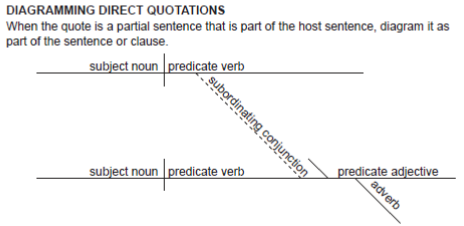 Diagramming Direct Quotations
Diagramming Direct QuotationsWhen diagramming direct quotations of complete sentences, simply diagram each sentence separately.
 Diagramming Direct Quotations
Diagramming Direct Quotations* American English Grammar And Writing Worksheets
<< This download has my favorite grammar PDFs for practice in elementary and middle school grammar lessons.
If you like the samples on this page, you'll love the grammar download which includes diagramming charts and English Grammar Definitions ebook.
These are great for easy practice and for ESL students.
Get the set. And enjoy!
* Karen Newell's Grammar And Writing Worksheets
Fast way to teach basic grammar!
Simple step by step workbook.
* Elizabeth O'Brien's English Grammar Revolution
Elizabeth O'Brian has the best diagramming workbooks I've seen. Her website also has videos to go with each lesson.
Diagramming Sentences is Easy!
I think that you'll really like our diagramming sentences worksheet printables at the top of this page. Thank you for sending your friends here to see them, too.
See more simple worksheets from our main grammar worksheets page or check out Karen's Grammar Slammer here.
Thank you for visiting PrintNPractice!
Curriculum for Diagramming Sentences
Remember how I said above that I hadn't seen the parts of speech on diagrams? It's true.
I have, to this day, only seen that one old book that did place the words subject-verb-object in their proper places on the diagram, and that must have been quite the feat since the words were hand written onto the diagram! Imagine the children today who have no idea!
Since I first wrote this in 2009, I've discovered Elizabeth O'Brien's English Grammar Revolution. She's done a wonderful job of teaching diagrams and has a full curriculum to make the job easy for both you and I.
If you like this way of teaching Grammar, she'll take you through a whole curriculum clear through high school level, sweet cheerful video instruction, workbooks, and all.
If you're looking for an easy and complete curriculum I'd like you to check what Elizabeth O'Brien has in her English Grammar Revolution workbooks, videos, and manuals.
* Elizabeth O'Brien's English Grammar Revolution
Elizabeth O'Brian has the best diagramming workbooks I've seen. Her website also has videos to go with each lesson.
Buy PDF Kids Printable Worksheets Organized By Topic In Complete Digital Bundles Or Learn More Below.

Mary Fifer, BSBA is webmaster, author, and researcher at PrintNPractice.com. She has created elementary school practice exercises using printable or digital interactive worksheets. Perfect for today's teachers, tutors, homeschoolers, and students!
Thank you for visiting and for sharing. :-)
Be encouraged to stay in touch! Join my free newsletter....

